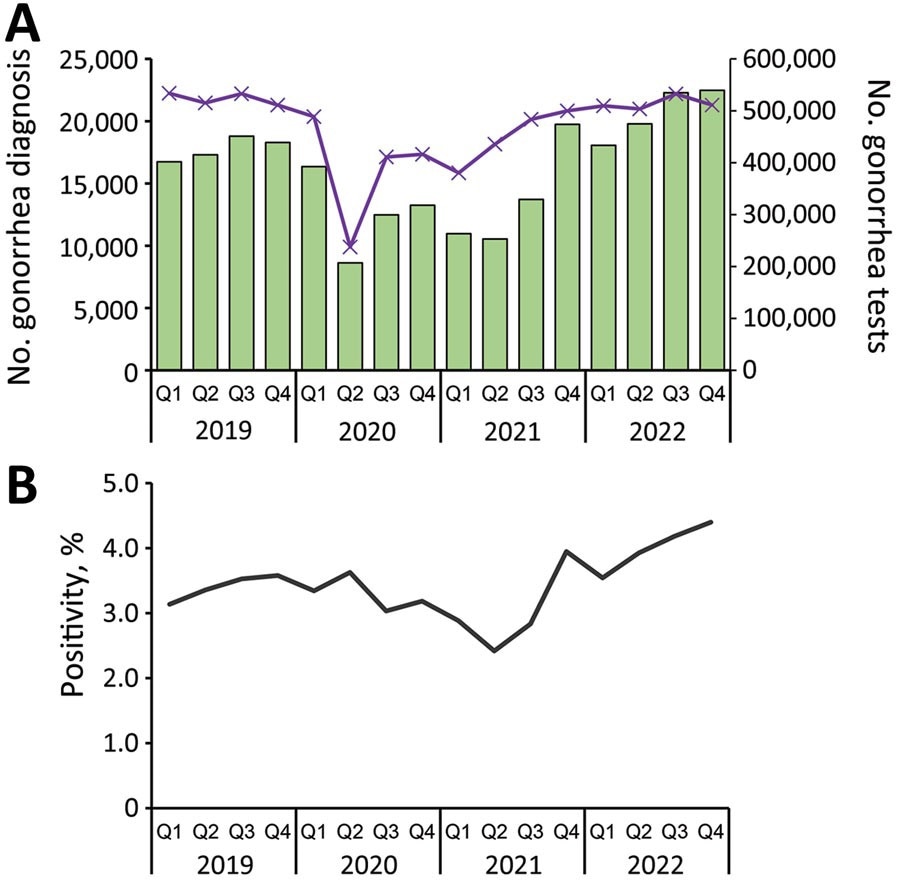In a recent study published in the journal Emerging Infectious Diseases, researchers analyzed data from the Genitourinary Medicine Clinic Activity Dataset STI Surveillance System, an English surveillance system monitoring sexually transmitted infections (STIs) within the country. Their findings revealed that in a little over a year following the relaxation of coronavirus disease 2019 (COVID-19)-related restrictions, positive Gonorrhea diagnoses increased by almost 64% (13,715 to 22,471) despite increases in STI testing rising by only 5.6%. These findings suggest that COVID-19 restrictions and its associated social distancing may have unintentionally suppressed the transmission of Gonorrhea and other STIs and highlight the need for policy measures aimed at preventing their resurgence following the pandemic.
 Dispatch: Rebound of Gonorrhea after Lifting of COVID-19 Preventive Measures, England. Image Credit: Giovanni Cancemi / Shutterstock
Dispatch: Rebound of Gonorrhea after Lifting of COVID-19 Preventive Measures, England. Image Credit: Giovanni Cancemi / Shutterstock
Gonorrhea and the unexpected benefits of the lockdown
Gonorrhea, colloquially known as ‘the clap,’ is a sexually transmitted infection (STI) caused by the bacterium Neisseria gonorrhoeae. While symptoms include pain or a burning sensation during urination, testicular (in men), or vaginal (in women) discomfort, discharge, or bleeding, the disease is often asymptomatic and undetectable without a clinical diagnosis.
Gonorrhea is one of the most common STIs in the world today, with research estimating that 0.8% of all men and 0.6% of all women live with the disease. Between 33 and 106 million novel incidences of the disease occur each year, though most are mild and treatable with antibiotics such as ceftriaxone by injection and azithromycin orally.
The coronavirus disease 2019 (COVID-19) pandemic forced numerous national governments, including those of the United Kingdom (UK), to impose restrictions and ‘lockdowns,’ legally enforcing social distancing to prevent the spread of the Severe Acute Respiratory Syndrome Coronavirus 2 (SARS-CoV-2) virus. An unintentional side-effect of these restrictions may have been the prevention of STI transmission through disruptions in medical health services due to the overwhelming number of COVID-19 cases that may have failed to report these positive outcomes.
“The COVID-19 pandemic caused a substantial disruption of sexual health services (SHS) in England (including reduced testing), contributing to a 33.5% decrease in new sexually transmitted infection (STI) diagnoses in 2020 (n = 311,480) compared with 2019 (n = 468,260).”
Following the lifting of England’s lockdown restrictions in July 2021, a rebound in SHS occurred, accounting for an almost 24% increased STI diagnoses rate (2022) compared to during the lockdown (2021). Alarmingly, positive gonorrhea diagnoses increased by more than 50% compared to COVID-19 times, but possible modes of transmission and at-risk populations remained hitherto unexplored.
About the study
In the present study, researchers use data from the Genitourinary Medicine Clinic Activity Dataset STI Surveillance System to elucidate trends in gonorrhea testing and diagnosis in England following the lifting of COVID-19 restrictions. Data from January 1, 2019, to December 31, 2022, was collected and analyzed, correcting for patients’ anthropometric and socio-demographic variables (age, sex, and sexual orientation).
Study findings
The present study findings reveal that while testing for Gonorrhea increased by 5.6% following the rebound of SHS, novel gonorrhea diagnoses increased by 63.8% compared to pandemic times. Study results highlight that individuals between the ages of 15 and 24 are at the highest risk of contracting the disease (141% increase) following restriction lifting. Alarmingly, the incidence of Gonorrhea was highest (229.0% increase) in individuals between the ages of 19 and 20 years.
Stratification of findings based on sexual orientation revealed that homosexual and bisexual men presented the highest prevalence, and homosexual women presented the highest novel incidence of the disease (104.7% increase; 2,577 to 5,274) between 2021 and 2022. Geographical stratification demonstrated that gonorrhea incidence increases were most significant in North East England (194%) and South West England (226.0%). However, all areas across the country presented statistically substantial increases compared to COVID-19-restriction times.

Total number of gonorrhea diagnoses and tests and percent test positivity in study of rebound of gonorrhea after lifting of COVID-19 preventive measures in England, January 1, 2019–December 31, 2022. A) Total number of diagnoses and tests. Bars indicate the total number of gonorrhea diagnoses; purple line indicates the total number of gonorrhea tests. B) Percent positivity of gonorrhea tests. Q, quarter. Scales for the y-axes differ substantially to underscore patterns but do not permit direct comparisons.
Conclusions
The present study reveals the STI-preventing side-effect of COVID-19-related restrictions and highlights the alarming resurgence of STIs, particularly Gonorrhea, following the lifting of these lockdowns. It further identified the age groups (15-24) and sexual orientations (men having sex with men, and women having sex with women) at highest risk of contracting the bacterial infection following restrictions removal.
“It remains to be seen whether increases in gonorrhea diagnoses will be short-lived because of restrictions removal, whether pre–COVID-19 pandemic diagnoses levels will resume, or whether another trend will be observed. Continued close surveillance, a better understanding of the factors leading to the increase in gonorrhea diagnoses, and public health messaging (particularly to young persons) are needed to focus efforts on gonorrhea transmission control and prevention.”